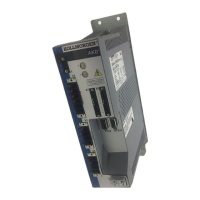AKD CANopen | 5 CANopen Basics
5.1 Basic Features implemented by CANopen
It is assumed that the basic operating functions of the communication profile are known and available as ref-
erence documentation. When working with the position controller that is integrated in AKD, the following func-
tions are available:
5.1.1 Setup and general functions:
l Homing, set reference point
l Provision of a digital setpoint for speed and torque control
l Support of the following modes of the CANopen Profile DS402:
l Profile position mode
l Homing mode
l Profile torque mode
l Interpolated position mode
l Profile velocity mode
l Cyclic synchronous position mode
5.1.2 Positioning functions:
l Execution of a motion task from the motion block memory of the drive
l Execution of a direct motion task
l Absolute trajectory, ip-Mode or csp-Mode
5.1.3 Data transfer functions:
l Transmit a motion task to the drive's motion block memory. A motion task consists of these elements:
l Position setpoint (absolute task) or path setpoint (relative task)
l Speed setpoint
l Acceleration time, braking time
l Type of motion task (absolute/relative)
l Number of a following task (with or without pause)
l Read a motion task from the motion block memory of the drive
l Read actual values
l Read the error register (Emergency error codes)
l Read the status register
l Read/write control parameters
5.2 Transmission Rate and Procedure
l Bus connection and bus medium: CAN-standard ISO 11898 (CAN high-speed)
l Transmission rate: max. 1Mbit/s
l Possible settings for the drive: 125 (default), 250, 500 and 1000 kbit/s
l The baudrate is set with the AKD - parameter FBUS.PARAM01. It gets effective by saving this parameter to
NVRAM and re-starting the drive.
24 Kollmorgen™ | November 2012

